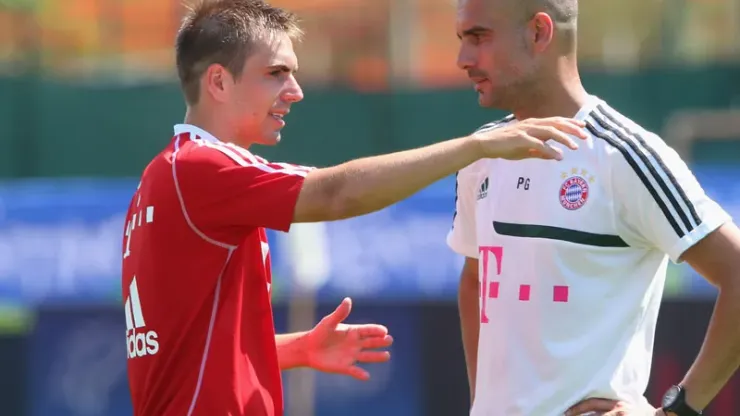One my most vivid footballing memories from years gone by was watching the first game of the 2006 World Cup.
It was a marvelous encounter between the hosts Germany and Costa Rica, and it began with a stunning goal from a 22-year-old left-back called Philipp Lahm. Ever since that excellent strike, I’ve always paid especially close attention to Lahm; from his performance in that World Cup opener right up until his most recent showing against Arsenal in the Champions League just shy of eight years on. That’s right, eight years!
Lahm is a player that whilst often acknowledged as one of the best full-backs on the planet, has always been a little under appreciated. Full-backs in the main, always are. “If you’re a full-back, you’re either a failed winger or a failed centre-back” joked Jamie Carragher on Sky earlier in the campaign.
But Lahm isn’t your typical full-back. He’s understated and relatively simple in his playing style, but his speed of thought is inimitable. His decision making in every facet of the game is nigh-on perfect: his passing, timing of runs, positioning and tackling.
So impressive that boss Pep Guardiola touted Lahm as the “most intelligent player” he’s ever worked with; quite the claim when you consider the talent the former Barcelona boss has had under his tutelage at both the Camp Nou and the Allianz Arena. Pretty decent for a “failed centre-back,” no?
Well, these days Lahm isn’t limited to the constraints of playing on the right or left-hand-side of the defence. Since taking over the European champions, Guardiola has used him primarily as the deepest lying midfield player in his 4-1-4-1 system; Lahm has flourished there.
The Bayern skipper has started 28 games this season, 21 times in midfield and 7 times at right-back (courtesy of Who Scored?). Those stats in themselves are a real testament as to how crucial Guardiola feels Lahm is in that position. Especially when you consider the riches he has available in central-midfield and the comparative lack of options available to him at right-back.
But it’s easy to see why. In that position—known as the “Sechser” in German football—Lahm can use his coveted football intellect to even greater effect. He manipulates the ball superbly, knowing exactly when to inject some tempo into Bayern’s play and vice-versa. At 30-years-old, he still has the energy to get about the pitch and defensively he is so sharp when anticipating danger before moving the ball on quickly.
LAHM’S SIGNIFICANCE ILLUSTRATED
At this juncture, Lahm as the “Sechser” has gone beyond the point of an experiment for Guardiola and his influence in midfield has grown in it’s significance to this Bayern team.
Just look at Bayern’s recent games against Arsenal, in particular the first leg. At the Emirates, their passing was a little aimless and cumbersome in the first half as the Gunners flew out of the traps.
Lahm started the game at right-back, but with Arsenal looking to sit in after the red card to Wojciech Szczesny, Guardiola drafted him back into midfield to inject pace, purpose and a little shrewdness into the team’s offensive play. Eventually Lahm set-up both Bayern goals and helped his team completely overwhelm the opposition.
In the second leg, the Bayern skipper again started at right-back. And although Bayern’s central midfield looked extraordinarily strong on paper ahead of this contest, they were not as fluid in their play, clearly missing not only the influence of Toni Kroos, but Lahm too.
His adaptability has become a key feature for Guardiola’s Bayern and as Franz Beckenbauer put it earlier in the campaign “Lahm is a phenomenon, the definition of the multifaceted player. He finds it is easy to adapt to every position. He’d probably even be good as a goalkeeper!”.
Bayern look set to dominate Germany and Europe once again with their skipper at the centre of their team in a very literal sense. But looking even further down the line, are Germany also set to benefit from Lahm’s versatility and Guardiola’s foresight?
Playing his skipper in midfield is something that the German national team boss Joachim Löw must have pondered long before he witnessed first-hand how Lahm inspired Bayern to victory over Arsenal in that first leg. Typically under Löw, Sami Khedira would partner Bastian Schweinsteiger in midfield, but the former has missed the majority of the season through injury, whilst Schweinsteiger himself is finding his feet again after a layoff.
Is it a void Lahm could fill? On the evidence of his performances this season, the answer would be an emphatic “yes”. From Löw’s point of view it could be a wise move too. The nexus of his German team will come from the Bayern Munich squad and the national boss might consider impinging a bit of Guardiola’s philosophy onto the German team, a philosophy which Lahm’s deployment in midfield is obviously vital to.
Out in the sweltering Brazilian heat, players who can keep their head, think fast and recycle possession of the ball are going to be key. So far this campaign, there haven’t been any players that have showcased these attributes in a more admirable light than Lahm.
200+ Channels With Sports & News
- Starting price: $33/mo. for fubo Latino Package
- Watch Premier League, Women’s World Cup, Euro 2024 & Gold Cup
The New Home of MLS
- Price: $14.99/mo. for MLS Season Pass
- Watch every MLS game including playoffs & Leagues Cup
Many Sports & ESPN Originals
- Price: $10.99/mo. (or get ESPN+, Hulu & Disney+ for $14.99/mo.)
- Features Bundesliga, LaLiga, Championship, & FA Cup
2,000+ soccer games per year
- Price: $5.99/mo
- Features Champions League, Serie A, Europa League & Brasileirāo
175 Premier League Games & PL TV
- Starting price: $5.99/mo. for Peacock Premium
- Watch 175 exclusive EPL games per season






